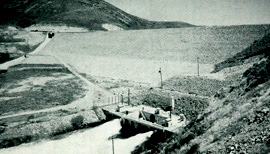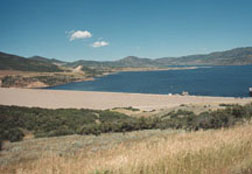Flashback – Water Development Milestones
Historically, the month of September has recorded events that have resulted in significant contributions to Salt Lake City’s water legacy.
LeRoy W. Hooton, Jr.
September 8, 2005
The following events occurred during the month of September:
130 years ago – Salt Lake City Begins Construction of its Municipal Water System
|
At the City Council meeting of September 21, 1875, Councilman Brigham Young motioned and carried to engage Ellerbeck to take charge of the entire Water Works and have full control of the construction project. Ellebeck resigned his position on June 22, 1877 when the work he had been hired to supervise was completed.
The labor for digging the pipe trench and backfilling the water mains was provided by laborers hired by the day and prisoners who worked out their fines at one dollar per day. Pipe and pipe fittings were caulked by pipe men from the gas company.
The piped water of City Creek was described as “sweet and pure,” compared to the water flowing in the open ditches. On October 6, 1876, the Deseret Evening News wrote, “Pure water running to your house….What a difference in the quality and the convenience of this water from that which runs in the ditches, either in the summer or in winter.” The cost of water from the new water works for a private residence, not exceeding 5 rooms with a connection to one water closet and one bath tub was $10, paid in advance semi-annually.
On June 30, 1876, the City Council passed an ordinance establishing the Salt Lake City Water Department to operate and maintain the water system.
Salt Lake City’s water system has grown over the past 130 years and today is the largest water distribution system in the Intermountain West, serving over 90,000 connections.
68 years ago – Deer Creek Project Special Election Date Set
|
The ballot asked two questions:
- “Shall the Metropolitan Water District of Salt Lake City, for the purpose of obtaining a water supply for the District, be authorized to enter into a contract by which it shall subscribe for 50,000 shares or so much thereof as may be available to subscription, of the capital stock of the Provo River Water User’s Association, on the terms and conditions and for the proposes set forth in the Ordinance by which this election is called?”
- “Shall the Metropolitan Water District of Salt Lake City be authorized to enter into a contract with the United States of America or the Provo River Water Users’ Association, or both of them, for the acquisition and construction of distribution facilities for the water supply of the District, on the terms and conditions and for the purposes set forth in the Ordinance by which this election is called?”
While the Metropolitan Water District of Salt Lake City was beginning the election process, other districts in Utah County were already holding elections. The Provo City voters were the first to consummate the subscription of 8,000 shares of stock in the Provo River Water Users’ Association by a 95 percent vote in favor. Subsequent elections were held in Orem, Lehi, Highland and American Fork with the same results. All of the elections passed by wide margins, except the election held in Lehi, which only passed by a mere 24 votes.
A record turnout of tax payers at the November 23 election voted on the two propositions, approving them by an unprecedented 23 to 1. “Both propositions carried by a majority which represented the nearest approach to unanimous approval ever achieved in any election in the history of the city,” noted the Salt Lake Tribune.
With the overwhelming approval of the tax payers, the Metropolitan Water District subscribed to 46,000 shares of stock in the Provo River Water Users Association. Later with an exchange with the Utah Lake Distributing Company, the District’s total equity in the project increased to 61.7 percent. Deer Creek Reservoir and the Salt Lake Aqueduct, including the Terminal Reservoirs were constructed and completed in 1950.
Today water stored in Deer Creek Reservoir and conveyed through the Salt Lake Aqueduct comprises 25 percent of Salt Lake City’s annual water supply.
20 years ago – Central Utah Project Bonneville Unit Special Election Scheduled
|
On September 12, 1985 the Central Utah Water Conservancy District board set November 19 for a special election to increase the debt ceiling. Additional funding was necessary to complete the remaining features of the project, particularly the construction of Jordanelle Dam located eight miles on the Provo River upstream of Heber City. Without a commitment to repay the federal government, the Bureau of Reclamation was unable to finish the project.
The November 19 special election passed by 73 percent with 93,415 ballots cast. All of the counties in the district except Uintah and Wasatch voted for increasing the debt limit to $508.9 million. Seventy-five percent of the voters in Salt Lake County voted for the increase. With voter approval, the Salt Lake Tribune wrote in an editorial, “The strong support is heartening evidence that Utahns are capable of facing the future, reviewing options for coping with anticipated growth, and carefully investing their dollars in a logical plan for developing much needed water.”
In 1986 the Metropolitan Water District of Salt Lake City signed a repayment contract with the Central Utah Water Conservancy District for 20,000 acre-feet of Bonneville Unit water to be delivered in incremental block notices of 4,000 acre-feet each year over a 5 year period. In the year 2005, the first 4,000 acre-foot increment of project water was delivered to the Metro District.
The Bonneville Unit of the Central Utah Project has at times been controversial; however it has proven to be an invaluable water supply for the State of Utah, especially fast growing Utah and Salt Lake Counties.


